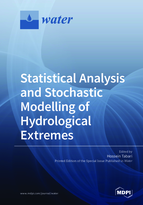Statistical Analysis and Stochastic Modelling of Hydrological Extremes
A special issue of Water (ISSN 2073-4441). This special issue belongs to the section "Water Resources Management, Policy and Governance".
Deadline for manuscript submissions: closed (31 May 2019) | Viewed by 70240
Special Issue Editor
Interests: statistical analysis of hydrological extremes; climate change/variability impact assessment on hydrology and water resources; monitoring and modeling of water availability and drought/water scarcity
Special Issues, Collections and Topics in MDPI journals
Special Issue Information
Dear Colleagues,
Assessment of hydrological extremes is of paramount importance, as they have the potential to affect society in terms of human health and mortality, and also may have effects on the ecosystem and economy (e.g., infrastructure and agriculture). In the last few decades, millions of people have been affected by hydrological extremes. The risk of these hazards will increase in the future as a result of climate change, and as population and infrastructure continue to increase and occupy areas exposed to higher risks. This Special Issue invites original research articles, as well as review articles, that address statistical analysis and stochastic modelling of hydrological extremes under current and future climate conditions. We are particularly interested in studies related to innovative stochastic and statistical approaches to analyze hydrological extremes. Potential topics include, but are not limited to:
- Decadal anomaly and trend analysis of historical hydrological extremes
- Anthropogenic and atmospheric drivers
- Assessment of uncertainties in hydrological projections and observations
- Application of statistical and dynamical downscaling methods
- Hydrological modeling under extreme conditions
- Early warning and forecasting systems
- Regional and global drought and flood analyses
- Adaptation and mitigation strategies
- Socio-environmental consequences of hydrological extremes
Dr. Hossein Tabari
Guest Editor
Manuscript Submission Information
Manuscripts should be submitted online at www.mdpi.com by registering and logging in to this website. Once you are registered, click here to go to the submission form. Manuscripts can be submitted until the deadline. All submissions that pass pre-check are peer-reviewed. Accepted papers will be published continuously in the journal (as soon as accepted) and will be listed together on the special issue website. Research articles, review articles as well as short communications are invited. For planned papers, a title and short abstract (about 100 words) can be sent to the Editorial Office for announcement on this website.
Submitted manuscripts should not have been published previously, nor be under consideration for publication elsewhere (except conference proceedings papers). All manuscripts are thoroughly refereed through a single-blind peer-review process. A guide for authors and other relevant information for submission of manuscripts is available on the Instructions for Authors page. Water is an international peer-reviewed open access semimonthly journal published by MDPI.
Please visit the Instructions for Authors page before submitting a manuscript. The Article Processing Charge (APC) for publication in this open access journal is 2600 CHF (Swiss Francs). Submitted papers should be well formatted and use good English. Authors may use MDPI's English editing service prior to publication or during author revisions.
Keywords
- Hydrological extremes
- Pluvial and fluvial floods
- Hydrological drought
- Forecasting models
- Climate change
- Decadal climate variability
- Uncertainty analysis






